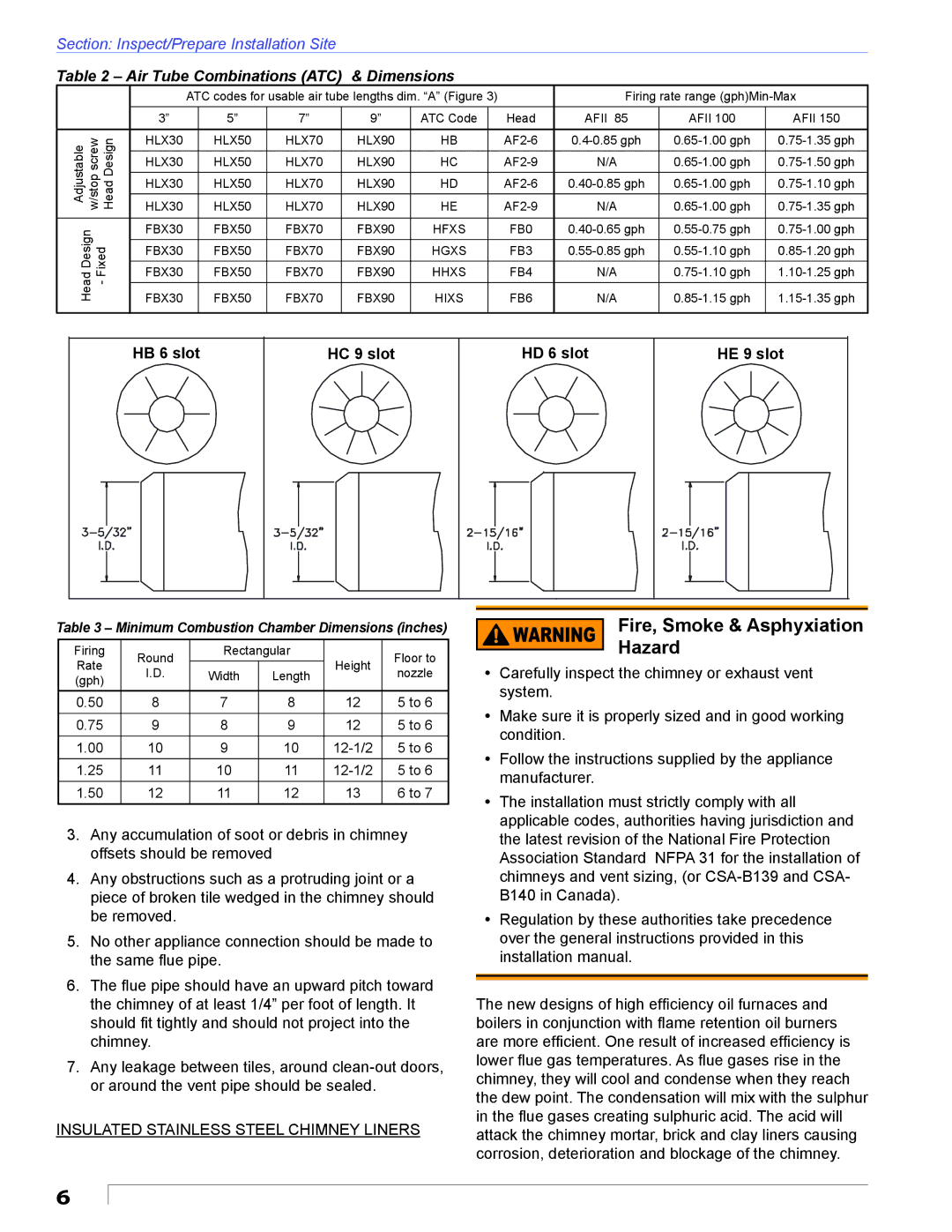
Section: Inspect/Prepare Installation Site
Table 2 – Air Tube Combinations (ATC) & Dimensions
|
|
|
| ATC codes for usable air tube lengths dim. “A” (Figure 3) |
| Firing rate range | |||||||
|
|
| 3” |
| 5” | 7” | 9” | ATC Code |
| Head | AFII 85 | AFII 100 | AFII 150 |
Adjustable screww/stop | DesignHead | HLX30 |
| HLX50 | HLX70 | HLX90 | HB |
| |||||
|
|
|
|
|
|
|
|
|
|
| |||
HLX30 |
| HLX50 | HLX70 | HLX90 | HC |
| N/A | ||||||
|
|
|
|
| |||||||||
|
|
| HLX30 |
| HLX50 | HLX70 | HLX90 | HD |
| ||||
|
|
|
|
|
|
|
|
|
|
|
|
|
|
|
|
| HLX30 |
| HLX50 | HLX70 | HLX90 | HE |
| N/A | |||
|
|
|
|
|
|
|
|
|
|
|
|
|
|
DesignHead |
|
| FBX30 |
| FBX50 | FBX70 | FBX90 | HFXS |
| FB0 | |||
Fixed- |
|
|
|
|
|
|
|
|
|
|
| ||
FBX30 |
| FBX50 | FBX70 | FBX90 | HGXS |
| FB3 | ||||||
|
|
|
|
| |||||||||
|
|
| FBX30 |
| FBX50 | FBX70 | FBX90 | HHXS |
| FB4 | N/A | ||
|
|
|
|
|
|
|
|
|
|
|
|
|
|
|
|
| FBX30 |
| FBX50 | FBX70 | FBX90 | HIXS |
| FB6 | N/A | ||
|
|
|
|
|
|
|
|
|
|
|
|
|
|
HB 6 slot | HC 9 slot | HD 6 slot | HE 9 slot |
Table 3 – Minimum Combustion Chamber Dimensions (inches)
Firing | Round | Rectangular |
| Floor to | ||
Rate |
|
| Height | |||
I.D. | Width | Length | nozzle | |||
(gph) |
| |||||
|
|
|
|
| ||
0.50 | 8 | 7 | 8 | 12 | 5 to 6 | |
0.75 | 9 | 8 | 9 | 12 | 5 to 6 | |
1.00 | 10 | 9 | 10 | 5 to 6 | ||
1.25 | 11 | 10 | 11 | 5 to 6 | ||
1.50 | 12 | 11 | 12 | 13 | 6 to 7 | |
3.Any accumulation of soot or debris in chimney offsets should be removed
4.Any obstructions such as a protruding joint or a piece of broken tile wedged in the chimney should be removed.
5.No other appliance connection should be made to the same flue pipe.
6.The flue pipe should have an upward pitch toward the chimney of at least 1/4” per foot of length. It should fit tightly and should not project into the chimney.
7.Any leakage between tiles, around
INSULATED STAINLESS STEEL CHIMNEY LINERS
Fire, Smoke & Asphyxiation
Hazard
yCarefully inspect the chimney or exhaust vent system.
yMake sure it is properly sized and in good working condition.
yFollow the instructions supplied by the appliance manufacturer.
yThe installation must strictly comply with all applicable codes, authorities having jurisdiction and the latest revision of the National Fire Protection Association Standard NFPA 31 for the installation of chimneys and vent sizing, (or
yRegulation by these authorities take precedence over the general instructions provided in this installation manual.
The new designs of high efficiency oil furnaces and boilers in conjunction with flame retention oil burners are more efficient. One result of increased efficiency is lower flue gas temperatures. As flue gases rise in the chimney, they will cool and condense when they reach the dew point. The condensation will mix with the sulphur in the flue gases creating sulphuric acid. The acid will attack the chimney mortar, brick and clay liners causing corrosion, deterioration and blockage of the chimney.
6
